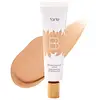What's inside
What's inside
 Key Ingredients
Key Ingredients

 Benefits
Benefits

 Concerns
Concerns

 Ingredients Side-by-side
Ingredients Side-by-side

Water
Skin ConditioningDimethicone
EmollientIsononyl Isononanoate
EmollientOctyldodecyl Stearoyl Stearate
EmollientGlycerin
HumectantPhenyl Trimethicone
Skin ConditioningMagnesium Sulfate
Octyldodecanol
EmollientHydrogenated Castor Oil
EmollientCetyl PEG/PPG-10/1 Dimethicone
EmulsifyingPolyglyceryl-3 Diisostearate
EmulsifyingDimethicone/Vinyl Dimethicone Crosspolymer
Skin ConditioningCetyl Dimethicone
EmollientDisteardimonium Hectorite
StabilisingLauroyl Lysine
Skin ConditioningPhenoxyethanol
PreservativePotassium Sorbate
PreservativeSodium Dehydroacetate
PreservativeTrimethylsiloxysilicate
EmollientSodium Benzoate
MaskingXanthan Gum
EmulsifyingDisodium EDTA
Tocopherol
AntioxidantPassiflora Edulis Seed Oil
EmollientSodium Hyaluronate
HumectantMelia Azadirachta Leaf Extract
Skin ConditioningMelia Azadirachta Flower Extract
Skin ConditioningCorallina Officinalis Extract
Skin ConditioningCoccinia Indica Fruit Extract
Skin ConditioningSolanum Melongena Fruit Extract
Skin ConditioningCollagen Amino Acids
MoisturisingAloe Barbadensis Flower Extract
EmollientLeuconostoc/Radish Root Ferment Filtrate
AntimicrobialSimmondsia Chinensis Seed Oil
EmollientCurcuma Longa Root Extract
MaskingOcimum Basilicum Flower/Leaf Extract
TonicOcimum Sanctum Leaf Extract
Skin ConditioningTitanium Dioxide
Cosmetic ColorantIron Oxides
Water, Dimethicone, Isononyl Isononanoate, Octyldodecyl Stearoyl Stearate, Glycerin, Phenyl Trimethicone, Magnesium Sulfate, Octyldodecanol, Hydrogenated Castor Oil, Cetyl PEG/PPG-10/1 Dimethicone, Polyglyceryl-3 Diisostearate, Dimethicone/Vinyl Dimethicone Crosspolymer, Cetyl Dimethicone, Disteardimonium Hectorite, Lauroyl Lysine, Phenoxyethanol, Potassium Sorbate, Sodium Dehydroacetate, Trimethylsiloxysilicate, Sodium Benzoate, Xanthan Gum, Disodium EDTA, Tocopherol, Passiflora Edulis Seed Oil, Sodium Hyaluronate, Melia Azadirachta Leaf Extract, Melia Azadirachta Flower Extract, Corallina Officinalis Extract, Coccinia Indica Fruit Extract, Solanum Melongena Fruit Extract, Collagen Amino Acids, Aloe Barbadensis Flower Extract, Leuconostoc/Radish Root Ferment Filtrate, Simmondsia Chinensis Seed Oil, Curcuma Longa Root Extract, Ocimum Basilicum Flower/Leaf Extract, Ocimum Sanctum Leaf Extract, Titanium Dioxide, Iron Oxides
Titanium Dioxide
Cosmetic ColorantZinc Oxide
Cosmetic ColorantCyclopentasiloxane
EmollientIsododecane
EmollientMica
Cosmetic ColorantPolysilicone-11
Polymethylsilsesquioxane
Hexyl Laurate
EmollientPEG-10 Dimethicone
Skin ConditioningPolyglyceryl-4 Isostearate
EmulsifyingStearic Acid
CleansingCetyl PEG/PPG-10/1 Dimethicone
EmulsifyingAlumina
AbrasiveTriethoxycaprylylsilane
Dipalmitoyl Hydroxyproline
Skin ConditioningDiamond Powder
AbrasiveIron Oxides
Titanium Dioxide, Zinc Oxide, Cyclopentasiloxane, Isododecane, Mica, Polysilicone-11, Polymethylsilsesquioxane, Hexyl Laurate, PEG-10 Dimethicone, Polyglyceryl-4 Isostearate, Stearic Acid, Cetyl PEG/PPG-10/1 Dimethicone, Alumina, Triethoxycaprylylsilane, Dipalmitoyl Hydroxyproline, Diamond Powder, Iron Oxides
Ingredients Explained
These ingredients are found in both products.
Ingredients higher up in an ingredient list are typically present in a larger amount.
This ingredient is a high molecular weight silicone. It has emulsifying and skin conditioning properties.
Titanium dioxide is a mineral UV filter widely used in sunscreens and cosmetics.
It is one of only two UV filters officially classified as “mineral” by regulatory agencies, the other being zinc oxide.
Titanium dioxide provides broad-spectrum protection mostly in the UVB and UVAII range, with some protection in the UVAI range.
While its UVA protection isn’t as strong as zinc oxide’s, the difference is minor.
A common myth is that mineral UV filters reflect UV light. However, modern research shows titanium dioxide absorbs UV radiation like chemical filters (~95% absorption & 5% reflection).
Thanks to its non-irritating nature, titanium dioxide is suitable for sensitive, acne-prone, or redness-prone skin. It is unlikely to cause "eye sting" like other sunscreen ingredients.
A major drawback of this ingredient is its white cast and thick texture. This is why mineral sunscreens often leave a white cast and are less cosmetically elegant than chemical/hybrid sunscreens.
To improve white cast and spreadability, micronized or nano-sized titanium dioxide is often used.
There are ongoing concerns surrounding nano-titanium oxide's impact on marine ecosystems.
There is no conclusive evidence that any form of titanium oxide (or any other sunscreen ingredients) will cause harm to marine ecosystems or coral reefs. The science is still developing but many consumers are keeping a close eye on this issue.
Please note, many destinations have reef-safety sunscreen rules. For instance, the U.S. Virgin Islands advises all visitors to use non-nano mineral sunscreens.
Nano mineral sunscreens once raised safety concerns about absorption into skin.
Extensive research has shown that they do not penetrate healthy or damaged skin; they remain safely on the surface and the top layer of dead skin (stratum corneum).
You'll likely find titanium dioxide bundled with alumina, silica, or dimethicone. These ingredients help make titanium dioxide highly photostable; this prevents it from interacting with other formula components under UV light.
Learn more about Titanium DioxideThis ingredient is a combination of red, black, and yellow iron oxide pigments. This combination of colors is usually found in foundation, because it results in a "skin" color.